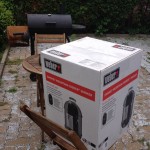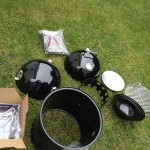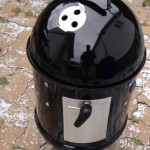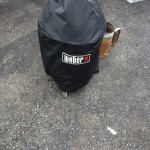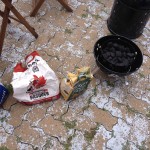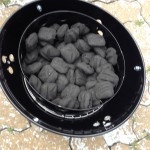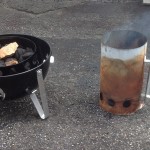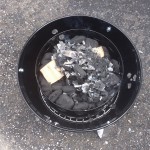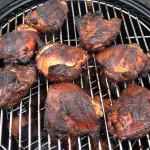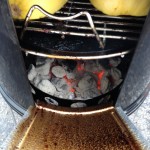Did my inaugural cook in the 14.5″ Weber Smokey Mountain my lifepartner is giving me for my birthday (she knows I don’t like surprises).
Will probably post some written notes of my smoking endeavours, at some point. In the meantime, some pictures documenting the whole thing.
Category Archives: cuisine
Diète stricte
J’ai pas vraiment l’habitude de bloguer sur des trucs du genre, mais si jamais ça peut être utile à d’autres…
En guise d’avertissement: je parle ici de santé et de digestion. Vais pas entrer dans des détails, mais c’est pas nécessairement agréable à lire à n’importe quel moment. Si vous êtes sensibles à ce genre de truc, ce billet peut avoir un mauvais effet. Aussi, je n’ai aucune formation dans le domaine de la santé, je ne parle que de mon expérience personnelle.
Depuis trois semaines, je suis sur une diète très stricte, recommandée par une naturopathe. Nous essayons d’identifier la cause exacte d’un trouble digestif que je subis depuis une dizaine d’années. Je vous épargne les détails (!) mais après seulement quelques jours (moins d’une semaine), je pouvais déjà voir des effets positifs. Essentiellement, si mon trouble digestif est pas disparu, il a déjà une toute autre proportion que ce qu’il a eu, au cours des dernières années.
Un truc important à noter, c’est que comme n’importe quel aspect de la santé, aucune solution ne convient à tout le monde. Ce que je suis, comme diète, est très spécifique à mes propres ennuis de santé.
Parmi les hypothèses, j’en note trois, principales:
- Maladie de cœliaque (intolérance au gluten)
- Candida (infection fongique)
- Parasite (assez logique, puisque ces troubles ont débuté au Mali)
Quoi qu’il en soit, voici les détails de ma diète…
Permis
- Riz brun
- Amande (y compris le lait d’amande non-sucré)
- Graine de citrouille
- Petits poissons blancs
- Millet
- Sarrasin
- Saumon du Pacifique
- Truite
- Riz blanc
- Tapioca
- Maïs
- Thé vert
Légumes cuits (en petites quantités)
- Courgette
- Courge
- Algue
- Chou frisé (“kale”)
- Carotte
- Panais
- Fenouil
- Oignon
- Poireau
- Céleri
- Pomme de terre
- Pois
- Haricot
Restreint
- Sucre
- Gluten
- Produit fermenté
- Alcool
- Produit laitier
- Fruit
- Viande
- Levure
- Champignon
- Tomate
- Œuf
- Poivron
- Légume cru
- Café
- Thé noir
- Saumon de l’Atlantique
- Noix (autres que les amandes)
- Légumineuses (autres que les pois et les haricots)
Honnêtement, c’est pas facile à tenir, comme diète. Au début, ce sont surtout les fruits qui me manquaient. Ces temps-ci, j’ai surtout envie d’œufs. Il y a eu plusieurs moments où j’aurais vraiment aimé pouvoir boire du café. Et je m’ennuie de la viande. Sans compter que je peux pratiquement rien manger en resto.
Faut dire que plusieurs de mes plaisirs passent par la bouffe ou par des situations qui tournent autour de la bouffe. On a beau dire, le thé vert a pas le même rôle que l’alcool ou même le café. Et comme je suis maniaque de café et que j’ai été brasseur maison, c’est pas très agréable de devoir me passer de tout ça. Compte tenu, surtout, de mon approche hédoniste.
M’ennuie de la diversité!
Sans compter que les restrictions alimentaires forment un sujet de conversation assez peu stimulant. Parler de ce genre de chose, c’est le contraire de briser la glace. Pas que ça cause un froid, mais c’est un sujet qui peut facilement monopoliser l’attention et qui amène rien de très utile.
Donc, pour un papillon social, c’est spécialement difficile, comme situation. Oh, je m’adapte. Je suis pas comme quelqu’un qui essaie d’arrêter de fumer ou de boire. Mais ça bouscule beaucoup de choses, dans ma vie. Ma joie de vivre est difficile à maintenir, même si les choses se passent bien dans d’autres dimensions de ma vie.
Mais il y a des bons côtés. Y compris les effets positifs sur ma santé.
Un effet intéressant de tout ça, c’est que je me suis mis à cuisiner tous mes repas, parfois en assez grandes quantités. Ça faisait un moment que je voulais m’y remettre et c’était pas idéal comme moment, mais ça s’est assez bien passé jusqu’à maintenant.
Et j’ai fait quelques «découvertes pour moi-même». Par exemple, je me rends compte que j’aime bien le millet, le chou frisé et les algues. Aussi, les graines de citrouilles grillées font un peu l’effet des graines de sésame grillées. Certains craquelins de riz (“rice cakes”) sont plus intéressants que d’autres. Et mon goût pour le thé vert se modifie.
Selon ma naturo, je vais peut-être pouvoir ajouter des éléments à la liste des aliments «permis», une fois qu’elle aurait les résultats de certains tests. J’espère vraiment que ça va être le cas. Si je devais m’astreindre à cette diète sur le long terme, ce serait difficile à vivre. Quelques restrictions à la fois, c’est déjà pas évident. Mais tout en même temps… Ouf!
Mais, bon, il faut ce qu’il faut.
Judging Coffee and Beer: Answer to DoubleShot Coffee Company
DoubleShot Coffee Company: More Espresso Arguments.
I’m not in the coffee biz but I do involve myself in some coffee-related things, including barista championships (sensory judge at regional and national) and numerous discussions with coffee artisans. In other words, I’m nobody important.
In a way, I “come from” the worlds of beer and coffee homebrewing. In coffee circles, I like to introduce myself as a homeroaster and blogger.
(I’m mostly an ethnographer, meaning that I do what we call “participant-observation” as both an insider and an outsider.)
There seem to be several disconnects in today’s coffee world, despite a lot of communication across the Globe. Between the huge coffee corporations and the “specialty coffee” crowd. Between coffee growers and coffee lovers. Between professional and home baristas. Even, sometimes, between baristas from different parts of the world.
None of it is very surprising. But it’s sometimes a bit sad to hear people talk past one another.
I realize nothing I say may really help. And it may all be misinterpreted. That’s all part of the way things go and I accept that.
In the world of barista champions and the so-called “Third Wave,” emotions seem particularly high. Part of it might have to do with the fact that so many people interact on a rather regular basis. Makes for a very interesting craft, in some ways. But also for rather tense moments.
About judging…
My experience isn’t that extensive. I’ve judged at the Canadian Eastern Regional BC twice and at the Canadian BC once.
Still, I did notice a few things.
One is that there can be a lot of camaraderie/collegiality among BC participants. This can have a lot of beneficial effects on the quality of coffee served in different places as well as on the quality of the café experience itself, long after the championships. A certain cohesiveness which may come from friendly competition can do a lot for the diversity of coffee scenes.
Another thing I’ve noticed is that it’s really easy to be fair, in judging using WBC regulations. It’s subjective in a very literal way since there’s tasting involved (tastebuds belong to the “subjects” of the sensory and head judges). But it simply has very little if anything to do with personal opinions, relationships, or “liking the person.” It’s remarkably easy to judge the performance, with a focus on what’s in the cup, as opposed to the person her-/himself or her/his values.
Sure, the championship setting is in many ways artificial and arbitrary. A little bit like rules for an organized sport. Or so many other contexts.
A competition like this has fairly little to do with what is likely to happen in “The Real World” (i.e., in a café). I might even say that applying a WBC-compatible in a café is likely to become a problem in many cases. A bit like working the lunch shift at a busy diner using ideas from the Iron Chef or getting into a street fight and using strict judo rules.
A while ago, I was working in French restaurants, as a «garde-manger» (assistant-chef). We often talked about (and I did meet a few) people who were just coming out of culinary institutes. In most cases, they were quite good at producing a good dish in true French cuisine style. But the consensus was that “they didn’t know how to work.”
People fresh out of culinary school didn’t really know how to handle a chaotic kitchen, order only the supplies required, pay attention to people’s tastes, adapt to differences in prices, etc. They could put up a good show and their dishes might have been exquisite. But they could also be overwhelmed with having to serve 60 customers in a regular shift or, indeed, not know what to do during a slow night. Restaurant owners weren’t that fond of hiring them, right away. They had to be “broken out” («rodés»).
Barista championships remind me of culinary institutes, in this way. Both can be useful in terms of skills, but experience is more diverse than that.
So, yes, WBC rules are probably artificial and arbitrary. But it’s easy to be remarkably consistent in applying these rules. And that should count for something. Just not for everythin.
Sure, you may get some differences between one judge and the other. But those differences aren’t that difficult to understand and I didn’t see that they tended to have to do with “preferences,” personal issues, or anything of the sort. From what I noticed while judging, you simply don’t pay attention to the same things as when you savour coffee. And that’s fine. Cupping coffee isn’t the same thing as drinking it, either.
In my (admittedly very limited) judging experience, emphasis was put on providing useful feedback. The points matter a lot, of course, but the main thing is that the points make sense in view of the comments. In a way, it’s to ensure calibration (“you say ‘excellent’ but put a ‘3,’ which one is more accurate?”) but it’s also about the goals of the judging process. The textual comments are a way to help the barista pay attention to certain things. “Constructive criticism” is one way to put it. But it’s more than that. It’s a way to get something started.
Several of the competitors I’ve seen do come to ask judges for clarifications and many of them seemed open to discussion. A few mostly wanted justification and may have felt slighted. But I mostly noticed a rather thoughtful process of debriefing.
Having said that, there are competitors who are surprised by differences between two judges’ scores. “But both shots came from the same portafilter!” “Well, yes, but if you look at the video, you’ll notice that coffee didn’t flow the same way in both cups.” There are also those who simply doubt judges, no matter what. Wonder if they respect people who drink their espresso…
Coming from the beer world, I also notice differences with beer. In the beer world, there isn’t really an equivalent to the WBC in the sense that professional beer brewers don’t typically have competitions. But amateur homebrewers do. And it’s much stricter than the WBC in terms of certification. It requires a lot of rote memorization, difficult exams (I helped proctor two), judging points, etc.
I’ve been a vocal critic of the Beer Judge Certification Program. There seems to be an idea, there, that you can make the process completely neutral and that the knowledge necessary to judge beers is solid and well-established. One problem is that this certification program focuses too much on a series of (over a hundred) “styles” which are more of a context-specific interpretation of beer diversity than a straightforward classification of possible beers.
Also, the one thing they want to avoid the most (basing their evaluation on taste preferences) still creeps in. It’s probably no coincidence that, at certain events, beers which were winning “Best of Show” tended to be big, assertive beers instead of very subtle ones. Beer judges don’t want to be human, but they may still end up acting like ones.
At the same time, while there’s a good deal of debate over beer competition results and such, there doesn’t seem to be exactly the same kind of tension as in barista championships. Homebrewers take their results to heart and they may yell at each other over their scores. But, somehow, I see much less of a fracture, “there” than “here.” Perhaps because the stakes are very low (it’s a hobby, not a livelihood). Perhaps because beer is so different from coffee. Or maybe because there isn’t a sense of “Us vs. Them”: brewers judging a competition often enter beer in that same competition (but in a separate category from the ones they judge).
Actually, the main difference may be that beer judges can literally only judge what’s in the bottle. They don’t observe the brewers practicing their craft (this happens weeks prior), they simply judge the product. In a specific condition. In many ways, it’s very unfair. But it can help brewers understand where something went wrong.
Now, I’m not saying the WBC should become like the BJCP. For one thing, it just wouldn’t work. And there’s already a lot of investment in the current WBC format. And I’m really not saying the BJCP is better than the WBC as an inspiration, since I actually prefer the WBC-style championships. But I sense that there’s something going on in the coffee world which has more to do with interpersonal relationships and “attitudes” than with what’s in the cup.
All this time, those of us who don’t make a living through coffee but still live it with passion may be left out. And we do our own things. We may listen to coffee podcasts, witness personal conflicts between café owners, hear rants about the state of the “industry,” and visit a variety of cafés.
Yet, slowly but surely, we’re making our own way through coffee. Exploring its diversity, experimenting with different brewing methods, interacting with diverse people involved, even taking trips “to origin”…
Coffee is what unites us.
How I Got Into Beer
Was doing some homebrewing experimentation (sour mash, watermelon, honey, complex yeast cultures…) and I got to think about what I’d say in an interview about my brewing activities.
It’s a bit more personal than my usual posts in English (my more personal blogposts are usually in French), but it seems fitting.
I also have something of a backlog of blogposts I really should do ASAP. But blogging is also about seizing the moment. I feel like writing about beer. 😛
So…
As you might know, the drinking age in Quebec is 18, as in most parts of the World except for the US. What is somewhat distinct about Qc with regards to drinking age is that responsible drinking is the key and we tend to have a more “European” attitude toward alcohol: as compared to the Rest of Canada, there’s a fair bit of leeway in terms of when someone is allowed to drink alcohol. We also tend to learn to drink in the family environment, and not necessarily with friends. What it means, I would argue, is that we do our mistakes in a relatively safe context. By the time drinking with peers becomes important (e.g., in university or with colleagues), many of us know that there’s no fun in abusing alcohol and that there are better ways to prove ourselves than binge drinking. According to Barrett Seaman, author of Binge: What Your College Student Won’t Tell You, even students from the US studying at McGill University in Montreal are more likely to drink responsibly than most students he’s seen in the US. (In Montreal, McGill tends to be recognized as a place where binge drinking is most likely to occur, partly because of the presence of US students. In addition, binge drinking is becoming more conspicuous, in Qc, perhaps because of media pressure or because of influence from the US.)
All this to say that it’s rather common for a Québécois teen to at least try alcohol at a relatively age. Because of my family’s connections with Switzerland and France, we probably pushed this even further than most Québécois family. In other words, I had my first sips of alcohol at a relatively early age (I won’t tell) and, by age 16, I could distinguish different varieties of Swiss wines, during an extended trip to Switzerland. Several of these wines were produced by relatives and friends, from their own vineyards. They didn’t contain sulfites and were often quite distinctive. To this day, I miss those wines. In fact, I’d say that Swiss wines are among the best kept secrets of the wine world. Thing is, it seems that Swiss vineyards barely produce enough for local consumption so they don’t try to export any of it.
Anyhoo…
By age 18, my attitude toward alcohol was already quite similar to what it is now: it’s something that shouldn’t be abused but that can be very tasty. I had a similar attitude toward coffee, that I started to drink regularly when I was 15. (Apart from being a homebrewer and a beer geek, I’m also a homeroaster and coffee geek. Someone once called me a “Renaissance drinker.”)
When I started working in French restaurants, it was relatively normal for staff members to drink alcohol at the end of the shift. In fact, at one place where I worked, the staff meal at the end of the evening shift was a lengthy dinner accompanied by some quality wine. My palate was still relatively untrained, but I remember that we would, in fact, discuss the wine on at least some occasions. And I remember one customer, a stage director, who would share his bottle of wine with the staff during his meal: his doctor told him to reduce his alcohol consumption and the wine only came in 750ml bottles. 😉
That same restaurant might have been the first place where I tried a North American craft beer. At least, this is where I started to know about craft beer in North America. It was probably McAuslan‘s St. Ambroise Stout. But I also had opportunities to have some St. Ambroise Pale Ale. I just preferred the Stout.
At one point, that restaurant got promotional beer from a microbrewery called Massawippi. That beer was so unpopular that we weren’t able to give it away to customers. Can’t recall how it tasted but nobody enjoyed it. The reason this brewery is significant is that their license was the one which was bought to create a little microbrewery called Unibroue. So, it seems that my memories go back to some relatively early phases in Quebec’s craft beer history. I also have rather positive memories of when Brasal opened.
Somewhere along the way, I had started to pick up on some European beers. Apart from macros (Guinness, Heineken, etc.), I’m not really sure what I had tried by that point. But even though these were relatively uninspiring beers, they somehow got me to understand that there was more to beer than Molson, Labatt, Laurentide, O’Keefe, and Black Label.
The time I spent living in Switzerland, in 1994-1995, is probably the turning point for me in terms of beer tasting. Not only did I get to drink the occasional EuroLager and generic stout, but I was getting into Belgian Ales and Lambics. My “session beer,” for a while, was a wit sold in CH as Wittekop. Maybe not the most unique wit out there. But it was the house beer at Bleu Lézard, and I drank enough of it then to miss it. I also got to try several of the Trappists. In fact, one of the pubs on the EPFL campus had a pretty good beer selection, including Rochefort, Chimay, Westmalle, and Orval. The first lambic I remember was Mort Subite Gueuze, on tap at a very quirky place that remains on my mind as this near-cinematic experience.
At the end of my time in Switzerland, I took a trip to Prague and Vienna. Already at that time, I was interested enough in beer that a significant proportion of my efforts were about tasting different beers while I was there. I still remember a very tasty “Dopplemalz” beer from Vienna and, though I already preferred ales, several nice lagers from Prague.
A year after coming back to North America, I traveled to Scotland and England with a bunch of friends. Beer was an important part of the trip. Though I had no notion of what CAMRA was, I remember having some real ales in diverse places. Even some of the macro beers were different enough to merit our interest. For instance, we tried Fraoch then, probably before it became available in North America. We also visited a few distilleries which, though I didn’t know it at the time, were my first introduction to some beer brewing concepts.
Which brings me to homebrewing.
The first time I had homebrew was probably at my saxophone teacher’s place. He did a party for all of us and had brewed two batches. One was either a stout or a porter and the other one was probably some kind of blonde ale. What I remember of those beers is very vague (that was probably 19 years ago), but I know I enjoyed the stout and was impressed by the low price-quality ratio. From that point on, I knew I wanted to brew. Not really to cut costs (I wasn’t drinking much, anyway). But to try different beers. Or, at least, to easily get access to those beers which were more interesting than the macrobrewed ones.
I remember another occasion with a homebrewer, a few years later. I only tried a few sips of the beer but I remember that he was talking about the low price. Again, what made an impression on me wasn’t so much the price itself. But the low price for the quality.
At the same time, I had been thinking about all sorts of things which would later become my “hobbies.” I had never had hobbies in my life but I was thinking about homeroasting coffee, as a way to get really fresh coffee and explore diverse flavours. Thing is, I was already this hedonist I keep claiming I am. Tasting diverse things was already an important pleasure in my life.
So, homebrewing was on my mind because of the quality-price ratio and because it could allow me to explore diverse flavours.
When I moved to Bloomington, IN, I got to interact with some homebrewers. More specifically, I went to an amazing party thrown by an ethnomusicologist/homebrewer. The guy’s beer was really quite good. And it came from a full kegging system.
I started dreaming.
Brewpubs, beerpubs, and microbreweries were already part of my life. For instance, without being a true regular, I had been going to Cheval blanc on a number of occasions. And my “go to” beer had been Unibroue, for a while.
At the time, I was moving back and forth between Quebec and Indiana. In Bloomington, I was enjoying beers from Upland’s Brewing Co., which had just opened, and Bloomington Brewing Co., which was distributed around the city. I was also into some other beers, including some macro imports like Newcastle Brown Ale. And, at liquor stores around the city (including Big Red), I was discovering a few American craft beers, though I didn’t know enough to really make my way through those. In fact, I remember asking for Unibroue to be distributed there, which eventually happened. And I’m pretty sure I didn’t try Three Floyds, at the time.
So I was giving craft beer some thought.
Then, in February 1999, I discovered Dieu du ciel. I may have gone there in late 1998, but the significant point was in February 1999. This is when I tried their first batch of “Spring Equinox” Maple Scotch Ale. This is the beer that turned me into a homebrewer. This is the beer that made me changed my perspetive about beer. At that point, I knew that I would eventually have to brew.
Which happened in July 1999, I think. My then-girlfriend had offered me a homebrewing starter kit as a birthday gift. (Or maybe she gave it to me for Christmas… But I think it was summer.) Can’t remember the extent to which I was talking about beer, at that point, but it was probably a fair bit, i.e., I was probably becoming annoying about it. And before getting the kit, I was probably daydreaming about brewing.
Even before getting the kit, I had started doing some reading. The aforementioned ethnomusicologist/homebrewer had sent me a Word file with a set of instructions and some information about equipment. It was actually much more elaborate than the starter kit I eventually got. So I kept wondering about all the issues and started getting some other pieces of equipment. In other words, I was already deep into it.
In fact, when I got my first brewing book, I also started reading feverishly, in a way I hadn’t done in years. Even before brewing the first batch, I was passionate about brewing.
Thanks to the ‘Net, I was rapidly amassing a lot of information about brewing. Including some recipes.
Unsurprisingly, the first beer I brewed was a maple beer, based on my memory of that Dieu du ciel beer. However, for some reason, that first beer was a maple porter, instead of a maple scotch ale. I brewed it with extract and steeped grain. I probably used a fresh pack of Coopers yeast. I don’t think I used fresh hops (the beer wasn’t supposed to be hop-forward). I do know I used maple syrup at the end of boil and maple sugar at priming.
It wasn’t an amazing beer, perhaps. But it was tasty enough. And it got me started. I did a few batches with extract and moved to all-grain almost right away. I remember some comments on my first maple porter, coming from some much more advanced brewers than I was. They couldn’t believe that it was an extract beer. I wasn’t evaluating my extract beer very highly. But I wasn’t ashamed of it either.
Those comments came from brewers who were hanging out on the Biéropholie website. After learning about brewing on my own, I had eventually found the site and had started interacting with some local Québécois homebrewers.
This was my first contact with “craft beer culture.” I had been in touch with fellow craft beer enthusiasts. But hanging out with Bièropholie people and going to social events they had organized was my first foray into something more of a social group with its associated “mode of operation.” It was a fascinating experience. As an ethnographer and social butterfly, this introduction to the social and cultural aspects of homebrewing was decisive. Because I was moving all the time, it was hard for me to stay connected with that group. But I made some ties there and I still bump into a few of the people I met through Bièropholie.
At the time I first started interacting with the Bièropholie gang, I was looking for a brewclub. Many online resources mentioned clubs and associations and they sounded exactly like the kind of thing I needed. Not only for practical reasons (it’s easier to learn techniques in such a context, getting feedback from knowledgeable people is essential, and tasting other people’s beers is an eye-opener), but also for social reasons. Homebrewing was never meant to be a solitary experience, for me.
I was too much of a social butterfly.
Which brings me back to childhood. As a kid, I was often ostracized. And I always tried to build clubs. It never really worked. Things got much better for me after age 15, and I had a rich social life by the time I became a young adult. But, in 2000-2001, I was still looking for a club to which I could belong. Unlike Groucho, I cared a lot about any club which would accept me.
As fun as it was, Bièropholie wasn’t an actual brewclub. Brewers posting on the site mostly met as a group during an annual event, a BBQ which became known as «Xè de mille» (“Nth of 1000”) in 2001. The 2000 edition (“0th of 1000”) was when I had my maple porter tasted by more advanced brewers. Part of event was a bit like what brewclub meetings tend to be: tasting each other’s brews, providing feedback, discussing methods and ingredients, etc. But because people didn’t meet regularly as a group, because people were scattered all around Quebec, and because there wasn’t much in terms of “contribution to primary identity,” it didn’t feel like a brewclub, at least not of the type I was reading about.
The MontreAlers brewclub was formed at about that time. For some reason, it took me a while to learn of its existence. I distinctly remember looking for a Montreal-based club through diverse online resources, including the famed HomeBrew Digest. And I know I tried to contact someone from McGill who apparently had a club going. But I never found the ‘Alers.
I did eventually find the Members of Barleyment. Or, at least, some of the people who belonged to this “virtual brewclub.” It probably wasn’t until I moved to New Brunswick in 2003, but it was another turning point. One MoB member I met was Daniel Chisholm, a homebrewer near Fredericton, NB, who gave me insight on the New Brunswick beer scene (I was teaching in Fredericton at the time). Perhaps more importantly, Daniel also invited me to the Big Strange New Brunswick Brew (BSNBB), a brewing event like the ones I kept dreaming about. This was partly a Big Brew, an occasion for brewers to brew together at the same place. But it was also a very fun social event.
It’s through the BSNBB that I met MontreAlers Andrew Ludwig and John Misrahi. John is the instigator of the MontreAlers brewclub. Coming back to Montreal a few weeks after BSNBB, I was looking forward to attend my first meeting of the ‘Alers brewclub, in July 2003.
Which was another fascinating experience. Through it, I was able to observe different attitudes toward brewing. Misrahi, for instance, is a fellow experimental homebrewer to the point that I took to call him “MadMan Misrahi.” But a majority of ‘Alers are more directly on the “engineering” side of brewing. I also got to observe some interesting social dynamics among brewers, something which remained important as I moved to different places and got to observe other brewclubs and brewers meetings, such as the Chicago Beer Society’s Thirst Fursdays. Eventually, this all formed the backdrop for a set of informal observations which were the corse of a presentation I gave about craft beer and cultural identity.
Through all of these brewing-related groups, I’ve been positioning myself as an experimenter. My goal isn’t necessarily to consistently make quality beer, to emulate some beers I know, or to win prizes in style-based brewing competitions. My thing is to have fun and try new things. Consistent beer is available anywhere and I drink little enough that I can afford enough of it. But homebrewing is almost a way for me to connect with my childhood.
There can be a “mad scientist” effect to homebrewing. Michael Tonsmeire calls himself The Mad Fermentationist and James Spencer at Basic Brewing has been interviewing a number of homebrewer who do rather unusual experiments.
I count myself among the ranks of the “Mad Brewers.” Oh, we’re not doing anything completely crazy. But slightly mad we are.
Through the selective memory of an adult with regards to his childhood, I might say that I was “always like that.” As a kid, I wanted to be everything at once: mayor, astronaut, fireman, and scholar. The researcher’s spirit had me “always try new things.” I even had a slight illusion of grandeur in that I would picture myself accomplishing all sorts of strange things. Had I known about it as a kid, I would have believed that I could solve the Poincaré conjecture. Mathematicians were strange enough for me.
But there’s something more closely related to homebrewing which comes back to my mind as I do experiments with beer. I had this tendency to do all sorts of concoctions. Not only the magic potions kids do with mud and dishwashing liquid. But all sorts of potable drinks that a mixologist may experiment with. There wasn’t any alcohol in those drinks, but the principle was the same. Some of them were good enough for my tastes. But I never achieved the kind of breakthrough drink which would please masses. I did, however, got my experimentation spirit to bear on food.
By age nine, I was cooking for myself at lunch. Nothing very elaborate, maybe. It often consisted of reheating leftovers. But I got used to the stove (we didn’t have a microwave oven, at the time). And I sometimes cooked some eggs or similar things. To this day, eggs are still my default food.
And, like many children, I occasionally contributing to cooking. Simple things like mixing ingredients. But also tasting things at different stages in the cooking or baking process. Given the importance of sensory memory, I’d say the tasting part was probably more important in my development than the mixing. But the pride was mostly in being an active contributor in the kitchen.
Had I understood fermentation as a kid, I probably would have been fascinated by it. In a way, I wish I could have been involved in homebrewing at the time.
A homebrewery is an adult’s chemistry set.
La Renaissance du café à Montréal
J’ai récemment publié un très long billet sur la scène du café à Montréal. Sans doûte à cause de sa longueur, ce billet ne semble pas avoir les effets escomptés. J’ai donc décidé de republier ce billet, section par section. Ce billet est la dernière section de ce long billet. Il consiste en une espèce de résumé de la situation actuelle de la scène montréalaise du café, avec un regard porté vers son avenir. Vous pouvez consulter l’introduction qui contient des liens aux autres sections et ainsi avoir un contexte plus large.
À mon humble avis, l’arrivée de la Troisième vague à Montréal nous permet maintenant d’explorer le café dans toute sa splendeur. En quelque sorte, c’était la pièce qui manquait au casse-tête.
Dans mon précédent billet, j’ai omis de comparer le café à l’italienne au café à la québécoise (outre l’importance de l’allongé). C’est en partie parce que les différences sont un peu difficile à expliquer. Mais disons qu’il y a une certaine diversité de saveurs, à travers la dimension «à la québécoise» de la scène montréalaise du café. Malgré certains points communs, les divers cafés de Montréalais n’ont jamais été d’une très grande homogénéité, au niveau du goût. Les ressemblances venaient surtout de l’utilisation des quelques maisons de torréfaction locales plutôt que d’une unité conceptuelle sur la façon de faire le café. D’ailleurs, j’ai souvent perçu qu’il y avait eu une baisse de diversité dans les goûts proposés par différents cafés montréalais au cours des quinze dernières années, et je considère ce processus de quasi-standardisation (qui n’a jamais été menée à terme) comme un aspect néfaste de cette période dans l’histoire du café à Montréal. Les nouveaux développements de la scène montréalaise du café me donne espoir que la diversité de cette scène grandit de nouveau après cette période de «consolidation».
D’ailleurs, c’est non sans fierté que je pense au fait que les grandes chaînes «étrangères» de cafés ont eu de la difficulté à s’implanter à Montréal. Si Montréal n’a eu sa première succursale Starbucks qu’après plusieurs autres villes nord-américaines et si Second Cup a rapidement dû fermer une de ses succursales montréalaises, c’est entre autres parce que la scène montréalaise du café était très vivante, bien avant l’arrivée des chaînes. D’ailleurs, plusieurs chaînes se sont développé localement avant de se disperser à l’extérieur de Montréal. Le résultat est qu’il y a probablement, à l’heure actuelle, autant sinon plus de succursales de chaînes de cafés à Montréal que dans n’importe autre grande ville, mais qu’une proportion significative de ces cafés est originaire de Montréal. Si l’existence de chaînes locales de cafés n’a aucune corrélation avec la qualité moyenne du café qu’on dans une région donnée (j’ai même tendance à croire qu’il y a une corrélation inverse entre le nombre de chaînes et la qualité moyenne du café), la «conception montréalaise» du café me semble révêlée par les difficultés rencontrées par les chaînes extrogènes.
En fait, une caractéristique de la scène du café à Montréal est que la diversité est liée à la diversité de la population. Non seulement la diversité linguistique, culturelle, ethnique et sociale. Mais la diversité en terme de goûts et de perspectives. La diversité humaine à Montréal évoque l’image de la «salade mixte»: un mélange harmonieux mais avec des éléments qui demeurent distincts. D’aucuns diront que c’est le propre de toute grande ville, d’être intégrée de la sorte. D’autres diront que Montréal est moins bien intégrée que telle ou telle autre grande ville. Mais le portrait que j’essaie de brosser n’est ni plus beau, ni plus original que celui d’une autre ville. Il est simplement typique.
Outre les cafés «à la québécoise», «à l’italienne» et «troisième vague» que j’ai décrits, Montréal dispose de plusieurs cafés qui sont liés à diverses communautés. Oui, je pense à des cafés liés à des communautés culturelles, comme un café guatémaltèque ou un café libanais. Mais aussi à des cafés liés à des groupes sociaux particuliers ou à des communautés religieuses. Au point de vue du goût, le café servi à ces divers endroits n’est peut-être pas si distinctif. Mais l’expérience du café prend un sens spécifique à chacun de ces endroits.
Et si j’ai parlé presqu’exclusivement de commerces liés au café, je pense beaucoup à la dimension disons «domestique» du café.
Selon moi, la population de la région montréalaise a le potentiel d’un réel engouement pour le café de qualité. Même s’ils n’ont pas toujours une connaissance très approfondie du café et même s’il consomme du café de moins bonne qualité, plusieurs Montréalais semblent très intéressés par le café. Certains d’entre eux croient connaître le café au point de ne pas vouloir en découvrir d’autres aspects. Mais les discussions sur le goût du café sont monnaie courante parmi des gens de divers milieux, ne serait-ce que dans le choix de certains cafés.
Évidemment, ces discussions ont lieu ailleurs et le café m’a souvent aidé à m’intégrer à des réseaux sociaux de villes où j’ai habité. Mais ce que je crois être assez particulier à Montréal, c’est qu’il ne semble pas y avoir une «idéologie dominante» du café. Certains amateurs de café (et certains professionnels du café) sont très dogmatiques, voire doctrinaires. Mais je ne perçois aucune idée sur le café qui serait réellement acquise par tous. Il y a des Tim Hortons et des Starbucks à Montréal mais, contrairement à d’autres coins du continent, il ne semble pas y avoir un café qui fait consensus.
Par contre, il y a une sorte de petite oligarchie. Quelques maisons de torréfaction et de distribution du café semblent avoir une bonne part du marché. Je pense surtout à Union, Brossard et Van Houtte (qui a aussi une chaîne de café et qui était pris à une certaine époque comme exemple de succès financier). À ce que je sache, ces trois entreprises sont locales. À l’échelle globale, l’oligarchie du monde du café est constituée par Nestlé, Sara Lee, Kraft et Proctor & Gamble. J’imagine facilement que ces multinationales ont autant de succès à Montréal qu’ailleurs dans le monde mais je trouve intéressant de penser au poids relatif de quelques chaînes locales.
Parlant de chaînes locales, je crois que certaines entreprises locales peuvent avoir un rôle déterminant dans la «Renaissance du café à Montréal». Je pense surtout à Café Terra de Carlo Granito, à Café Mystique et Toi, Moi & Café de Sevan Istanboulian, à Café Rico de Sévanne Kordahi et à la coop La Maison verte à Notre-Dame-de-Grâce. Ces choix peuvent sembler par trop personnels, voire arbitraires. Mais chaque élément me semble représentatif de la scène montréalaise du café. Carlo Granito, par exemple, a participé récemment à l’émission Samedi et rien d’autre de Radio-Canada, en compagnie de Philippe Mollé (audio de 14:30 à 32:30). Sevan Istanboulian est juge certifié du World Barista Championship et distribue ses cafés à des endroits stratégiques. Sévanne Kordahi a su concentrer ses activités dans des domaines spécifiques et ses cafés sont fort appréciés par des groupes d’étudiants (entre autres grâce à un rabais étudiant). Puis j’ai appris dernièrement que La Maison verte servait du Café Femenino qui met de l’avant une des plus importantes dimensions éthiques du monde du café.
Pour revenir au «commun des mortels», l’amateur de café. Au-delà de la spécificité locale, je crois qu’une scène du café se bâtit par une dynamique entre individus, une série de «petites choses qui finissent par faire une différence». Et c’est cette dynamique qui me rend confiant.
La communauté des enthousiastes du café à Montréal est somme toute assez petite mais bien vivante. Et je me place dans les rangs de cette communauté.
Certains d’entre nous avons participé à divers événements ensemble, comme des dégustations et des séances de préparation de café. Les discussions à propos du café se multiplient, entre nous. D’ailleurs, nous nous croisons assez régulièrement, dans l’un ou l’autre des hauts lieux du café à Montréal. D’ailleurs, d’autres dimensions du monde culinaire sont représentés parmi nous, depuis la bière artisanale au végétalianisme en passant par le chocolat et le thé. Ces liens peuvent sembler évident mais c’est surtout parce que chacun d’entre nous fait partie de différents réseaux que la communauté me semble riche. En discutant ensemble, nous en venons à parler de plusieurs autres arts culinaires au-delà du café, ce qui renforce les liens entre le café et le reste du monde culinaire. En parlant de café avec nos autres amis, nous créons un effet de vague, puisque nous participons à des milieux distincts. C’est d’ailleurs une représentation assez efficace de ce que je continue d’appeler «l’effet du papillon social»: le battement de ses ailes se répercute dans divers environnements. Si la friction n’est pas trop grande, l’onde de choc provenant de notre communauté risque de se faire sentir dans l’ensemble de la scène du café à Montréal.
Pour boucler la boucle (avant d’aller me coucher), je dois souligner le fait que, depuis peu, le lieu de rencontre privilégié de notre petit groupe d’enthousiastes est le Café Myriade.
Café à la montréalaise
Montréal est en passe de (re)devenir une destination pour le café. Mieux encore, la «Renaissance du café à Montréal» risque d’avoir des conséquences bénéfiques pour l’ensemble du milieu culinaire de la métropole québécoise.
Cette thèse peut sembler personnelle et je n’entends pas la proposer de façon dogmatique. Mais en me mêlant au milieu du café à Montréal, j’ai accumulé un certain nombre d’impressions qu’il me ferait plaisir de partager. Il y a même de la «pensée magique» dans tout ça en ce sens qu’il me semble plus facile de rebâtir la scène montréalaise du café si nous avons une idée assez juste de ce qui constitue la spécificité montréalaise.
Omnivoring Conspiracies
Yup, I occasionally like to jump on bandwagons. Especially when they’re full of food and is being mentioned in a video presenting a cool local event in which I happen to take part. Alejna put the final nail in that coffin with her own use of that list.
From the Very Good Taste blog:
Very Good Taste » blog » The Omnivore’s Hundred.
So, here goes. A list of food items used as a “meme.”
The rules:
1) Copy this list into your blog or journal, including these instructions.
2) Bold all the items you’ve eaten.
3) Cross out any items that you would never consider eating.
4) Optional extra: Post a comment here at www.verygoodtaste.co.uk linking to your results.
1. Venison (I like game)
2. Nettle tea (also nettle wine)
3. Huevos rancheros (but I prefer migas)
4. Steak tartare (especially horse tartare)
5. Crocodile (not yet)
6. Black pudding (not that I really like it but I did have some)
7. Cheese fondue (several different types, including Fribourg’s moitié-moitié, “tarragon fondue” served on potatoes, and the three cheese classic)
8. Carp (fished by hand)
9. Borscht (only once or twice in restaurants)
10. Baba ghanoush (pretty common)
11. Calamari (I prefer fried over stuffed)
12. Pho (in my list of comfort foods, with bánh mỳ)
13. PB&J sandwich (not that frequently)
14. Aloo gobi (had some this afternoon, as a matter of fact)
15. Hot dog from a street cart (although Montreal has rules against them)
16. Epoisses (not sure I did; does it taste a bit like cancoillotte? I do remember having that…)
17. Black truffle (not by itself, though)
18. Fruit wine made from something other than grapes (especially if apfelwein counts, but I’ve tasted other fruit wines)
19. Steamed pork buns (why would you have dim sum and avoid those?)
20. Pistachio ice cream (one that I had recently was especially yummy)
21. Heirloom tomatoes (I tend to be rather picky about tomatoes and I should have heirloom ones more frequently)
22. Fresh wild berries (oh, yes! I’m not a big fan of strawberries but wild strawberries are very nice. And the raspberries! Oh, the raspberries! Throughout Quebec, wild berries are really very common.)
23. Foie gras (though not on a poutine)
24. Rice and beans (for a while, it became my mainstay dish)
25. Brawn, or head cheese (and I’ve helped make some)
26. Raw Scotch Bonnet pepper (not raw but I’ve had a fair bit cooked)
27. Dulce de leche (only discovered it a few years ago but it does go in the comfort food list)
28. Oysters (though I tend to prefer them au gratin than raw)
29. Baklava (I especially like the pistacchio ones but they’re always good anyway)
30. Bagna cauda (Nope! Sounds interesting, though.)
31. Wasabi peas (what I like about these is that the spiciness is just a short little tinge and it leaves your tastebuds able to taste other things)
32. Clam chowder in a sourdough bowl (the first time may have been at Tufts)
33. Salted lassi (I like those kinds of tastes, almost reminds me of Tibetan tea)
34. Sauerkraut (just tonight, in fact!)
35. Root beer float (and tried other float experiments)
36. Cognac with a fat cigar (I don’t smoke but I did visit some distilleries in the Cognac region)
37. Clotted cream tea (only clotted cream on scones, to accompany tea)
38. Vodka jelly/Jell-O (only a few times: not my kind of thing)
39. Gumbo (I especially like it in Malian tô but I had some Indian gumbo this afternoon)
40. Oxtail (Swiss style)
41. Curried goat (not sure, actually; I’ve had goat, I’ve had curried meats, not sure about curried goat)
42. Whole insects (I’m not against it but I haven’t seeked that out as a culinary experience)
43. Phaal (I don’t think I did but I do like some South Indian dishes like that)
44. Goat’s milk (I’ve had yoghurt, ice cream, and cheese made of goat’s milk but not goat’s milk by itself)
45. Malt whisky from a bottle worth £60/$120 or more (I’m guessing the cask strength Oban was worth something like that. If not, some of our tasting sessions in Scotland may have including something like this.)
46. Fugu (nope, but I’ve been intrigued)
47. Chicken tikka masala (all the Indian chicken dishes I like)
48. Eel (mostly in sushi)
49. Krispy Kreme original glazed doughnut (overrated)
50. Sea urchin (mostly in a paste with sake: delicious)
51. Prickly pear (I’m pretty sure I did and I know I’ve had it in juice)
52. Umeboshi (sounds good, though! I’m pretty much a drupe-lover)
53. Abalone (I like most molluscs so I’m guessing I’d like it)
54. Paneer (made some: fun and tasty)
55. McDonald’s Big Mac Meal (way back when…)
56. Spaetzle (very common in Switzerland)
57. Dirty gin martini (I probably prefer it without the olive juice, though I like a dry martini with olives)
58. Beer above 8% ABV (I’ve made some)
59. Poutine (Quebec cuisine FTW!)
60. Carob chips (these were trendy at some point)
61. S’mores (a friend made an espresso drink based on those)
62. Sweetbreads (not among my favourite but we’ve done ris de veau at a restaurant where I used to work)
63. Kaolin (clay??)
64. Currywurst (I like pretty much all sausage dishes, though)
65. Durian (heard about it, intrigued about the smell)
66. Frogs’ legs (though most French-Canadians have never eaten them, it’s still the reason we’re called frogs)
67. Beignets, churros, elephant ears or funnel cake (and queue de castor)
68. Haggis (nope, but intriguing)
69. Fried plantain (we even did a whole “fried food” event and fried plantain was a big success)
70. Chitterlings, or andouillette (not among my favourites)
71. Gazpacho (our family version is chunky but I’ve had other versions)
72. Caviar and blini (thanks to French housemates)
73. Louche absinthe (as well as straight)
74. Gjetost, or brunost (sounds interesting)
75. Roadkill (although, it depends how it’s prepared)
76. Baijiu (I’m pretty sure I did but it might have been another liquor)
77. Hostess Fruit Pie (sometimes, convenience store food just makes sense)
78. Snail (especially in garlic butter)
79. Lapsang souchong (among my favourite teas, along with genmaicha)
80. Bellini (I remember the taste so I guess I’ve had it, but I’m not positive)
81. Tom yum (I tend to be picky about it but I do enjoy it)
82. Eggs Benedict (and all sorts of variations on the theme)
83. Pocky (had similar chocolate coate cookies but I’m not sure they taste the same)
84. Tasting menu at a three-Michelin-star restaurant. (If only…)
85. Kobe beef (I’m trying to remember… I’ve had tasty Japanese beef but it probably wasn’t ever kobe)
86. Hare (and my ex-wife used to hunt them, as a kid)
87. Goulash (one that I remember was at Les Assassins, in Paris, but it had more to do with the settings)
88. Flowers (not whole fresh ones, though)
89. Horse (among my favourite meats)
90. Criollo chocolate (I probably did but it wasn’t pointed out)
91. Spam (I don’t dislike it but it’s not really my thing)
92. Soft shell crab (I did fish for soft shell crab but we didn’t eat them)
93. Rose harissa (didn’t know about that one but I love harissa)
94. Catfish (one of the first times was as a sandwich at the bus station in Gary, IN and I really liked it)
95. Mole poblano (and if I were still in Austin, I’d be having it regularly)
96. Bagel and lox (especially with real Montreal-style bagels, which I much prefer to New York style ones)
97. Lobster Thermidor (I prefer lobster with garlic butter)
98. Polenta (both as part of savoury dishes and with jam)
99. Jamaican Blue Mountain coffee (as overrated as overrated can get)
100. Snake (but I imagine I’d like it)
My impression of the list is that it’s somewhat typical of “foodie culture” among Anglo-Americans. Many of these items are quite common in different parts of the world yet they represent “novelty items” in the UK/US. A few items have to do with actual rarity (the rose harissa is a good example) and I perceive foodie culture to be typically oriented toward “making sure you’ve tasted all the rarest items at least once.”
Of course, the list includes a number of items which are supposed to gross out people. In fact, that’s probably a big part of “the whole thing,” the concept behind the “meme.” Though any food culture has a distinction between edible and inedible items, this emphasis on “grossing out” is, I find, very typical of Anglo-American attitudes toward food. In a way, food is compartmentalized by what is perceived as its very nature and little attention is paid to the joy of eating as a social process. In fact, this list places food smack in the middle of consumption culture and takes it away from the culture of experience.
I mentioned that I find Blue Mountain coffee and Krispy Kreme donuts to be overrated. The fact that they’re part of the list seems significant, in my mind. I perceive Krispy Kreme to be a “mass-marketed fad,” even though the donuts are decent. Blue Mountain coffee beans are a bigger issue. Those who don’t know coffee seem to associate certain broad coffee varietals with quality coffee and expensive coffee beans with a guarantee of quality. There are diverse problems with that. Between the quality of the varietal and the taste of the cup are a large number of factors including the specific estate, the specific crop, the picking method, the washing method, the roasting process, the freshness of the beans, and the whole brewing process (including grinding, water, manipulation, and device).
I’ve had coffee made with very expensive beans (more expensive than Blue Mountain) that was really very good and I’ve had much less expensive coffee which produced a wonderful cup. Blue Mountain coffee I’ve had tended to fall below my threshold for quality coffee. Same thing with most Kona beans. And though I’ve never had kopi luwak, I don’t necessarily want to try it just because it’s a novelty item.
One thing about my own list… There are several things which I’m unsure about. It may look like I’m not paying attention or that I’m pretending that I’ve had “the real thing.” But I tend to pay a lot of attention to experience, not to brands or novelty. For instance, I’m quite convinced I’ve had chocolate made from criollo varieties of beans. The criollo varieties might even have been mentioned when I was eating (or drinking) that chocolate. I certainly remember hearing about criollo varieties. But I care more about the taste of a specific chocolate at a given time, in a given context than about making sure I’ve had what’s considered the most “refined” version.
I’m more one to seek out a slightly better muffin. Or, more accurately, I’m one to try out muffins at different places and keep in mind something nice about all the pleasant muffin experiences I’ve had. I have in mind a generic “muffinness” and there are times when I feel like having a specific kind of muffin. But I’m never claiming that one muffin is intrinsically better than the other. Even when I say something is “good” or “better,” I never really have standards in mind, absolute or relative.
One thing I do like about this Omnivore list is that it pushed me to think about different food items. I quite enjoy thinking about food. And the list does include items which are fairly diverse (though they’re all available in semi-mainstream Anglo-American locations). There are patterns (in terms of Indian and Japanese cuisines, for instance), but it’s still a bit more open-minded than the typical stripmall. About the same level of openness to the world’s culinary diversity as a Whole Foods location.
Come to think of it, what if this list had been planted as a way to assess interest for items to be sold by a supermarket chain?
It’s all a conspiracy.
Dismissive Naysayers (Rant)
Ok, I must really be in a ranting spree… 😉
Feels kind of good. 🙂
Don’t worry, it won’t last. 😎
So… Why is it that people occasionally seem forced to be dismissive with people who like something that they themselves happen not to like? You know, in culinary articles, movie reports, political rallies, book reviews… Quite frequently, a negative description of a cultural item will read like “if you like this, you must be an idiot.” Instead of the more useful: “I don’t like this and I think it’s flawed in some ways but if you’re in the mood for this kind of book/meal/movie/experience, you might enjoy it. I respect your tastes, I just don’t share them.”
Now. Some people who know e might think I’m talking about them. I’m not. Really, I’m not talking about anyone in particular. Not even about a category of people. I’m just describing a behavior. At least, I’m trying to.
Even though this is (yet another) rant, I don’t think I’m even really complaining about this kind of behavior. I’m just talking about it. Venting, yes, ok. But not really whining/complaining/dismissing. I know it sounds like something else, but I’m pretty sure I know how I feel about the whole thing. No, I don’t particularly enjoy this behavior. But I can deal with it. I’m fine. I don’t want to eradicate the behavior. I just elucidate.
I’m mostly talking about my puzzlement at this behavior. IMHO, if you don’t like something, there’s really no use in ruining it for other people. I mean, is it supposed to be funny, or something? Is it a way to brag about having a sophisticated palate, about being well-read, about having attained a high degree of media literacy?
Now, I’m sure I’ve done exactly the same thing on occasion. If I don’t enjoy it too much from other people, I hate it coming from my own sorry self. It just doesn’t correspond to my way of thinking about basically anything. If I’ve done it, I guess it might have come from a weird dynamic in which I entered by mistake. Not that it’s an excuse. I don’t need an excuse for something which is not inherently bad. But I do want to understand what’s going on.
I keep wondering how people would react when they are told something like “you’re an idiot for loving a person like this.” That, I’m pretty sure I never said to anyone. If I ever did, something really strange must have happened. But it does happen occasionally. And I wonder how people feel because it might be a path to awareness. Not that an appreciation of “a thing” is in any way similar to an attachment to a human being. But the dismissive sentiment seems to me relatively similar in both cases.
Maybe I’m wrong. About the whole thing. Maybe I just don’t get it and some people just have “superior taste” about everything than anybody else and when they say “it’s bad,” it really means that there’s no way to ever appreciate this thing in any context if you’re a worthy human being. Sure, it’s possible.
I just prefer being an hedonist. 🙂
And I prefer venting occasionally. Not on a regular basis. 😉
Food and Satisfaction
Catherine and I have a lot to celebrate. Her recent offer from Austin, her less recent doctoral defense, ten years of living together… We had promised ourselves one truly good restaurant meal. In fact, this promise was made several times over the past year or so but we had never been able to fulfill it. Continue reading Food and Satisfaction
Individualism, Freedom, and Food
A surprisingly superficial podcast episode on what could have been a very deep subject.
Open Source » Blog Archive » The End of Free Will?
start a conversation about manipulation, persuasion and freedom from choice
To summarize the main issue of that episode: is marketing and "upselling" by restaurant chains undermining the individual freedom to choose quality food? Apparently simple a question, but billed as much more than that.
Maybe they refrained from delving deeper into any of those issues because philosophical discussions, perhaps aesthetic ones especially, are off limits in "polite company" in U.S. media. Too bad.
Actually, I’m genuinely disappointed. Not necessarily because restaurant chains are very important an issue for me (in Montreal, they don’t seem to have the exact same type of impact and I love to cook). But because the show’s participants all came very close to saying very important things about individualism, food, and freedom. The first two are too rarely discussed, IMHO, and the third could have been the "hook" to discuss the other two.
Ah, well…
If you want to know more about my thoughts on this podcast episode, check out some of the tags below.
